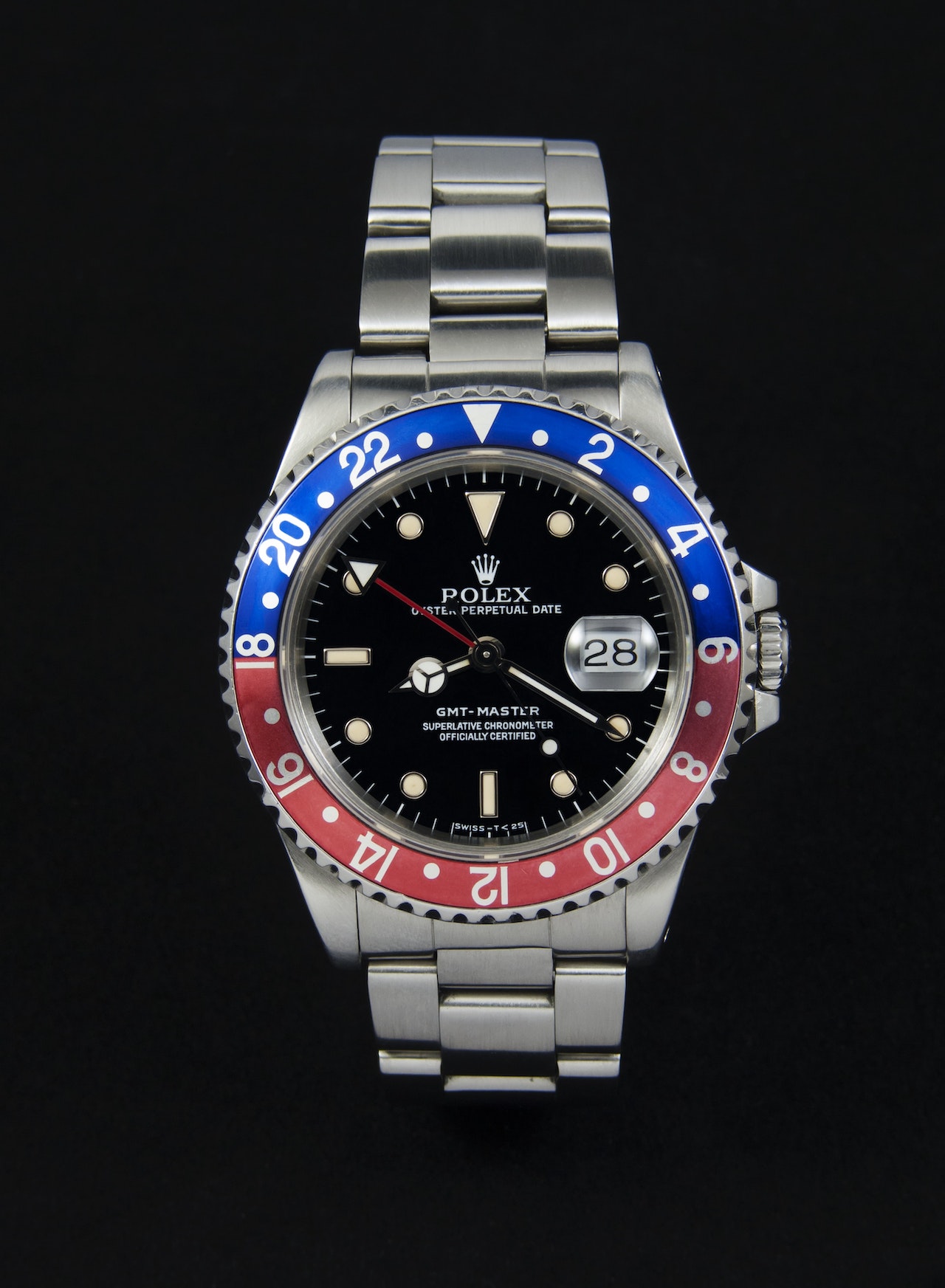
Over the years, Rolex has been responsible for some of the most sought-after watches within the watch space. None being more iconic than the ‘Pepsi’ GMT-Master. With its instantly recognizable red and blue bezel, the Pepsi has become a piece every watch enthusiast wants to own. Let’s look into the history of this GMT watch and what makes it such a desirable collector’s piece.
Evolution of the GMT-Master
In 1954 American airline company, Pan American Airlines, approached Rolex to design a watch for their commercial pilots. They wanted a watch that had the functionality of displaying dual time zones. What was created was the GMT-Master, reference 6542.
Its bi-directional bezel allowed pilots to quickly determine the local time, given they knew how many time zones were crossed. The watch just turned around the business for Rolex. The bezel had a red and blue colorway which represented whether it was day (06:00 to 18:00) or night (18:00 to 06:00). These colors led watch collectors to coin this GMT-Master as the Pepsi.
The Original Pepsi
This production run of ref. 6542 ran from 1955 to 1959. It had a 38mm stainless steel case and a Bakelite bezel insert. However, the Bakelite material was prone to cracking. Forcing Rolex to change to an aluminum bezel within first two years of production.
Due to this change, it is very difficult to find the Bakelite configuration undamaged. Making it one of the most coveted vintage Rolex pieces for watch collectors.
Longest Production Model
Reference 1675 was the next configuration of GMT-Master Pepsi and was launched in 1959. Production of this model ran through until 1980, which made it one of the longest-running references in Rolex’s history.
Ref. 1675 retained the aluminum bezel implemented on its predecessor and welcomed some new features. It’s case size was increased from 38mm to 40mm, and crown guards were introduced. Giving it a more sleak appearance.
Transitional Period
The next iteration of the Rolex Pepsi, ref. 16750, ran between 1980 and 1988 and was known as a transitional period for Rolex. During this time, there were several significant changes implemented.
A quickset date function was made possible by introducing a new movement, caliber 3075, allowing the date to be set independently from the hour hand. The matte dials that were used on ref. 1675 were swapped for a glossy dial which contained white gold surrounds for each hour marker.
The Age Of The GMT-Master II
From 1989 to 2007 GMT-Master Pepsi saw two reference models, ref. 16700 and ref. 16710, the former being discontinued in 1999 in favor of Rolex’s GMT-Master II. Model’s could be differentiated by the GMT-Master II ability to independently adjust both 12-hour and 24-hour hands. This allowed users to operate the bezel as a third-time zone.
In 1997, tritium dials were changed for Luminova and then Super Luminova in 2000. This continued until 2007 when the Rolex Pepsi configuration was discontinued.
The Return
After 7 years of being out of production, Rolex’s iconic Pepsi bezel was reintroduced on a white gold case ref. 116719BLRO. It retained its 40mm case and featured their new proprietary ceramic alloy, Cerachrom, leaving the old aluminum bezel behind. This was a feat in itself after Rolex claimed it to be near impossible to feature a two-tone color scheme on a Cerachrom bezel.
The movement was upgraded, Caliber 3186, with a blue Parachrom hairspring allowing it to withstand greater temperature variations and magnetic fields. As this model was made from white gold, it limited what hands it fell into. This was due to its increase in price compared to previous models. making it a more elusive piece for collectors.
Modern Day GMT Master Pepsi
In 2018, to the delight of watch collectors, Rolex brought back it’s steel version of the Pepsi ref. 126710BLRO. It held on to its 40mm Oystersteel case but packed a new generation movement, Caliber 3285. Which increased its power reserve from 50 to 70 hours.
However, in true Rolex fashion, they left the community wanting more. This was because ref. 126710BLRO only come on a steel Jubilee bracelet. It took 3 years for Rolex to finally release the Pepsi on both Jubilee and its sportier looking Oyster bracelet. Having satisfied customers needs for both bracelets it subsequetly increased demand making it even tougher for collectors to own.
Rolex also made changes to their white gold model ref. 126719BLRO. They now offered two new dial variations; a royal blue dial which contrasted well with the bezel and an incredible meteorite dial. This dial was crafted using actual pieces of Gibeon meteorite which was discovered in Namibia, Africa. Due to the naturally occurring patterns within the elements structure no two dials share identical characteristics. Giving each piece their own uniqueness and elevating it to another level of luxury timepiece.
The Pepsi’s Impact
It’s evident that the Pepsi stood the test of time. While constantly evolving, it became exponentially popular with watch enthusiasts. Since the GMT-Masters conception Rolex have offered other color variations such as black and blue (The Batman) and black and red (The Coke). However the legendary red and blue has always been number one as shown by Rolex choosing to include it on their white gold and meteorite model.
However, no bigger compliment can be made to a watch than other brands recognizing its popularity and paying homage in their own way. This has been done by several big names such as; Tudor, with the Black Bay GMT, Tag Heuer, with the Aquaracer GMT and the extremely affordable Q Timex Reissue. Most of these alternative options are readily available and at a much cheaper price point, allowing collectors to feel a part of the rich history that GMT Master Pepsi created.
You may be interested in: Why Are Rolex Cellini Watches the Best?

